Multi-unit restaurant operators face the continual challenge of balancing the delicate equation between providing top-notch dining experiences and maintaining healthy profit margins. One critical aspect that directly impacts a restaurant’s financial health is spend management, where understanding the distinctions between direct and indirect spend plays a pivotal role.
While the terms “direct” and “indirect” might sound straightforward, their application within the context of foodservice procurement can be multifaceted and nuanced. By gaining a comprehensive understanding of these differences, operators can make informed decisions, optimize resource allocation, and pave the way for sustainable growth and success in this dynamic industry.
What is Direct Spend?
Direct spend refers to the procurement of goods and services that are directly involved in the production and preparation of food and beverages for a restaurant or food establishment. These are the expenses incurred on items that are essential for the core operations of the business.
Examples of Common Direct Spend Categories:
Food ingredients: This includes all the raw materials and ingredients used in cooking and preparing dishes, such as vegetables, meat, seafood, spices, and other essential food items.
Beverages: The cost of purchasing beverages, such as soft drinks, alcoholic beverages, coffee, and tea, falls under direct spend.
Kitchen equipment and utensils: Expenses related to acquiring and maintaining kitchen equipment like ovens, stoves, refrigerators, knives, and other utensils are considered direct spend.
Packaging and disposables: Costs associated with containers, takeout boxes, napkins, and other disposables used to serve food directly to customers.
Cleaning supplies: The expenditure on cleaning products and hygiene essentials for maintaining kitchen and dining areas.
Direct spend is a crucial aspect of foodservice operations and managing it efficiently can contribute to cost control and ultimately impact the profitability and success of a restaurant or foodservice establishment.
What is Indirect Spend?
Indirect Spend refers to the procurement of goods and services that are not directly involved in the production and preparation of food and beverages but are essential for the overall functioning and support of the restaurant or food establishment. These are the expenses incurred on items that are necessary for the smooth running of the business but are not directly related to the core operations.
Examples of Common Indirect Spend Categories:
Facility maintenance: Expenses related to maintaining the physical infrastructure of the restaurant, such as repairs, renovations, and upkeep of the building and equipment.
Cleaning and janitorial services: The cost of outsourcing cleaning services for the restaurant premises, including regular cleaning and deep cleaning.
Office supplies: Expenditure on items like paper, pens, printer ink, and other office essentials used for administrative purposes.
Marketing and advertising: Costs associated with promoting the restaurant, including advertising campaigns, social media marketing, and promotional materials.
Staff training and development: Expenses related to training programs, workshops, and educational materials for employees to enhance their skills and knowledge.
Utilities: The costs of utilities like electricity, water, gas, and internet services required to run the restaurant.
Insurance: Payments made for various types of insurance coverage, such as property insurance, liability insurance, and worker’s compensation insurance.
Indirect spend, while not directly impacting the food preparation, plays a vital role in the overall efficiency and success of the foodservice business. Proper management of indirect spend can contribute to cost savings and improve the overall performance of the restaurant.
What is the difference between Direct and Indirect Spend?
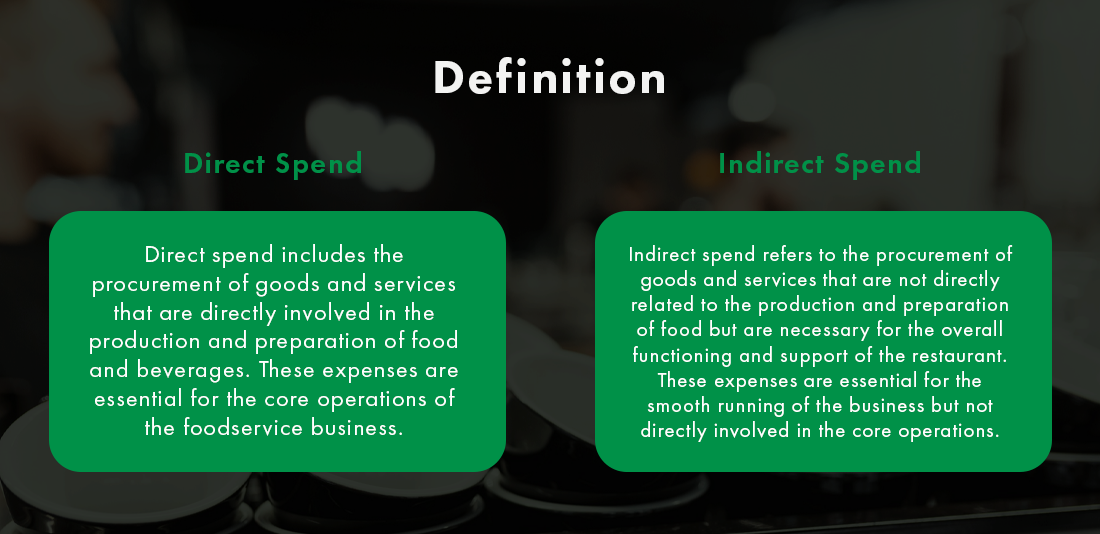
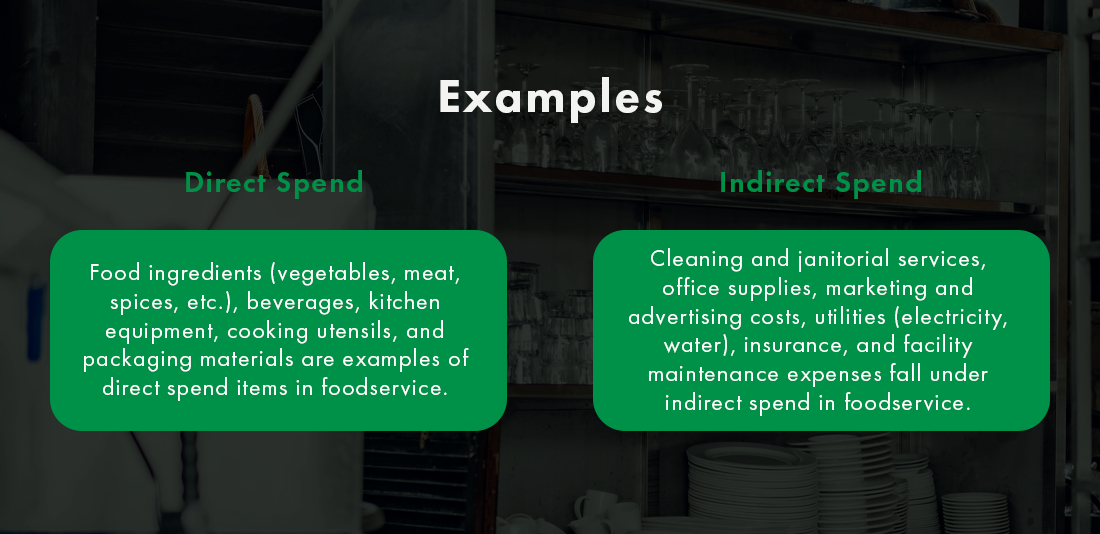
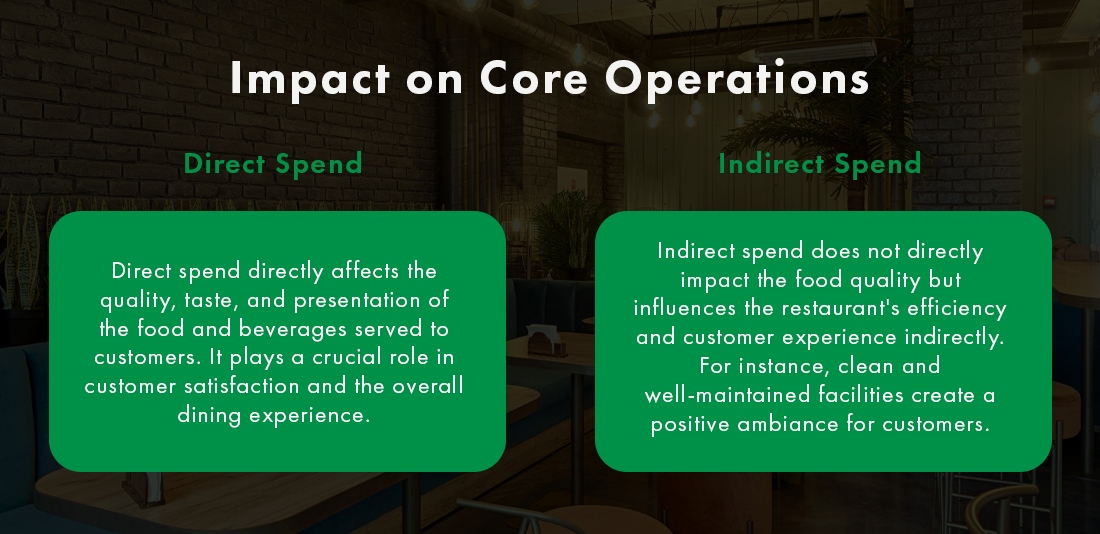
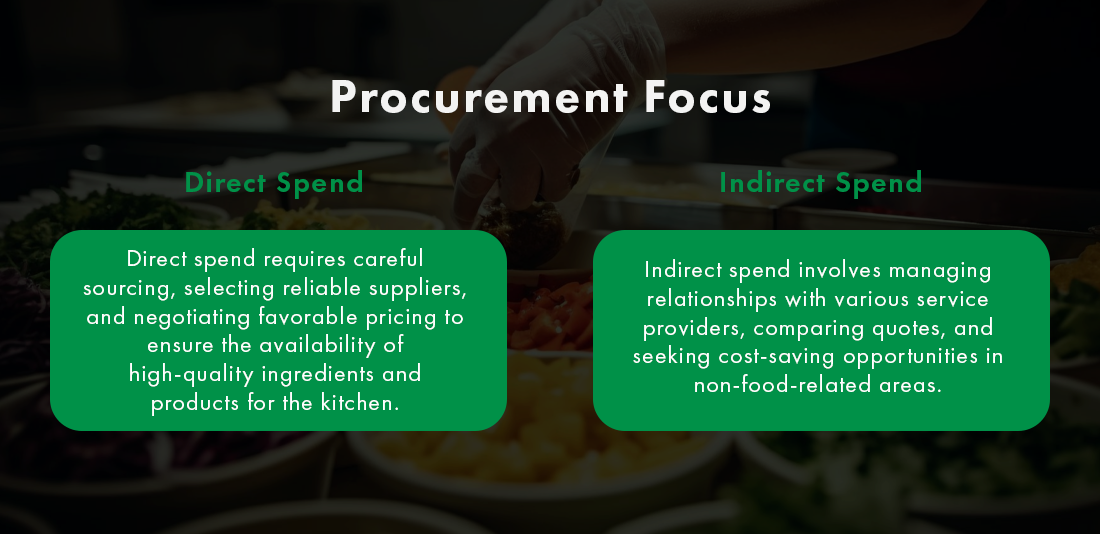
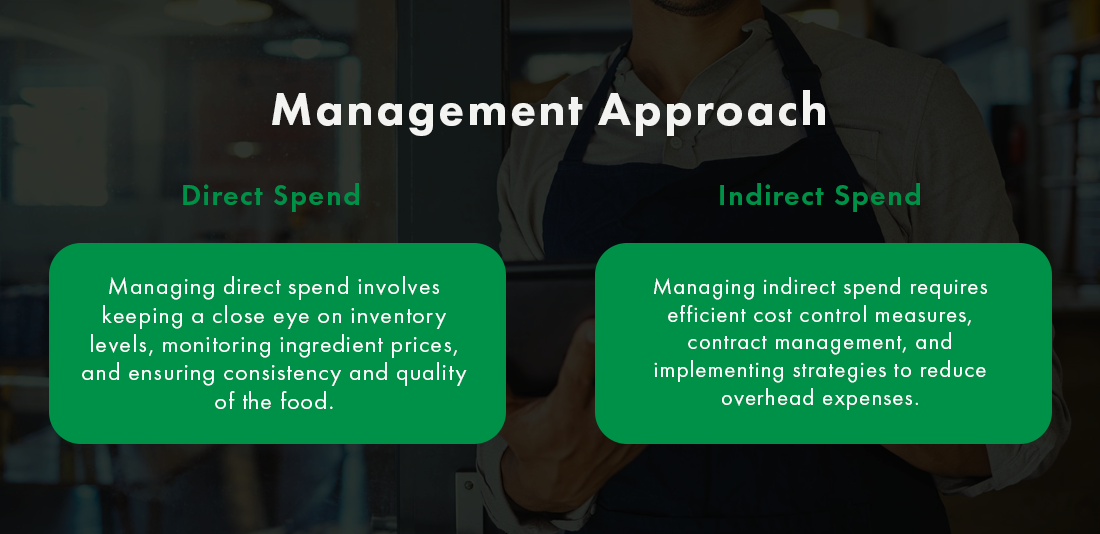
How do I manage my direct and indirect spend?
Managing direct and indirect spend for multiple locations as a multi-unit restaurant operator requires careful planning, coordination, and a centralized approach to procurement. Here are some strategies to effectively manage direct and indirect spend across multiple restaurant locations:
Leverage Technology and E-Procurement: Implement e-procurement systems and technology to streamline the purchasing process. E-procurement can centralize supplier databases, automate purchase orders, and facilitate electronic invoices, making it easier to manage spend efficiently.
Centralized Procurement: Establish a centralized procurement team or department responsible for managing purchasing decisions for all locations. Centralizing purchasing allows for better coordination, leverage in negotiations, and streamlined processes.
Standardized Supplier Agreements: Negotiate standardized supplier agreements that cover all locations. This approach helps in securing consistent pricing, terms, and conditions, reducing the risk of variation in spend across different locations.
Implement Spend Analysis and Reporting: Utilize spend analysis and reporting tools to track and analyze spending across all locations. This data-driven approach enables you to identify spending patterns, areas of potential cost savings, and opportunities for consolidation.
Supplier Consolidation: Whenever possible, consolidate suppliers across multiple locations to negotiate better pricing and terms. By sourcing from a smaller number of trusted suppliers, you can achieve economies of scale and reduce administrative overhead.
Group Purchasing Organizations (GPOs): Consider joining a Group Purchasing Organization to pool purchasing power with other restaurant operators. GPOs negotiate contracts with suppliers on behalf of their members, enabling access to better pricing and deals.
Regular Reviews and Audits: Conduct regular reviews and audits of spending to ensure compliance with procurement policies and identify any discrepancies or areas for improvement.
Implement Budget Controls: Set clear spending budgets for each location and monitor adherence to those budgets closely. Implement approval processes for purchases exceeding a certain threshold to maintain financial discipline.
Training and Communication: Train and communicate with restaurant managers and staff about spend management policies, cost-saving initiatives, and the importance of adhering to centralized procurement guidelines.
Share Best Practices: Facilitate communication and collaboration between restaurant managers across different locations. Share best practices and successful cost-saving strategies to foster continuous improvement.
Sustainable and Ethical Sourcing: Emphasize sustainable and ethical sourcing practices across all locations to align with consumers’ increasing demand for environmentally conscious businesses.
Stay Updated on Market Trends: Stay informed about market trends, pricing fluctuations, and emerging technologies that can further optimize your spend management across multiple locations.
By implementing these strategies and maintaining a centralized approach, multi-unit restaurant operators can effectively manage direct and indirect spend, optimize costs, maintain consistent quality, and drive sustainable growth across their restaurant locations.
By becoming a member of Consolidated Concepts, you can empower your staff to enhance their procurement process, improve cost efficiency, and focus on providing exceptional dining experiences across all locations.
With access to our trusted network of suppliers, restaurant operators can navigate the complexities of direct and indirect spend more effectively and achieve sustainable growth in a competitive industry. As a Group Purchasing Organization (GPO), we wield the collective buying power of multiple restaurants, unlocking exclusive savings on all your supplies, from fresh ingredients to essential services. Say goodbye to procurement headaches and embrace our centralized approach, ensuring consistency, accountability, and data-driven insights that’ll keep your business thriving.



Comment(01)